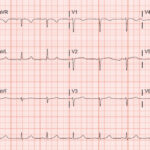‘Cath’ It Before It’s Too Late: A Case Report of ECG Abnormalities Indicative of Acute Pathology Requiring Immediate Catheterization
ABSTRACT:
Current guidelines to detect for myocardial infarction (MI) are not sufficient to triage patients requiring immediate cardiac catheterization, with at least 25% of non-ST elevation myocardial infarction (NSTEMI) patients found to have acute coronary occlusion (ACO) only on delayed catheterization, and up to 35% of perceived ST-elevation myocardial infarction (STEMI) ACOs found as false positives at catheterization. There has been a call for an integration of a new paradigm: occlusion/non-occlusion MI (OMI/NOMI). Here we discuss a 51-year-old female who presented to the emergency department with subtle electrocardiogram (ECG) abnormalities not adherent to the current MI guidelines. However, the subtle abnormalities when combined with her history and risk factors point to a high probability of a pathological amount of coronary disease that required immediate catheterization. This case report illustrates the importance in revisiting current guidelines and the need to integrate OMI/NOMI alongside current guidelines to guide decision making for immediate reperfusion needs.
Topics:
Occlusion, myocardial infarction, ST elevation myocardial infarction, acute coronary syndromes, electrocardiography.




